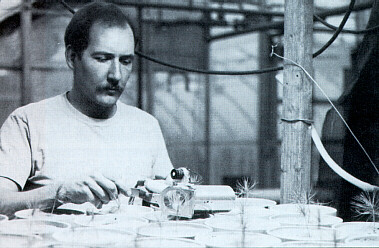 The first year of a newly germinated tree seedling is the most
critical phase of its life. It must successfully compete against
an already well established understory plant community for light,
water, and nutrients. In addition, it must be able to quickly
acclimate to the varying micro-climate it has sprouted in. Why
do some tree seedlings survive where all others fail? The answers
may help protect future forests.
The first year of a newly germinated tree seedling is the most
critical phase of its life. It must successfully compete against
an already well established understory plant community for light,
water, and nutrients. In addition, it must be able to quickly
acclimate to the varying micro-climate it has sprouted in. Why
do some tree seedlings survive where all others fail? The answers
may help protect future forests.
Ponderosa pine (Pinus ponderosa) is one of the most versatile, economically important, and ecologically significant components of forest and rangeland ecosystems in the western United States. It generally dominates the ecotones between forest and grasslands, and those relatively dry areas within northwestern forest ecosystems that are difficult to restore after disturbance. Ponderosa pine also occurs as a dominant seral species on more productive forest ecosystems, often when they have been severely disturbed. Comparative studies have shown that an ability to tolerate high temperature and low soil moisture allows ponderosa pine to grow where other tree species fail to become established. Seedling survival however, can be quite poor and sporadic under these environmental conditions.
Natural or human-caused disturbances such as fire or clear-cutting generally change the microclimate of a forest or rangeland ecosystem from a mesic to a more arid and hotter environment. In particular, daytime soil surface temperatures can be substantially higher compared to undisturbed environments. On such disturbed sites, ponderosa pine is important in facilitating restoration. The mechanisms by which this uniquely steadfast tree survives drought and high temperatures form the basis of our study.
Native perennial bunchgrasses, predominantly bluebunch wheatgrass (Agropyron spicatum) and Idaho fescue (Festuca idahoensis), are often found in association with ponderosa pine, usually on the harsher sites the species occupies. We predicted that competition between bunchgrasses and pine seedlings was responsible for the poor survival rate of naturally-established pine seedlings. But we were also aware that the grasses may act as nurse-plants, shielding pine seedlings from intense sunlight.
The first part of our study was designed to determine the degree of competition between naturally-established pine seedlings and bunchgrasses. At the University of Idaho Experimental Forest we shielded seedling shoots from the bunchgrass canopy with wire mesh to examine aboveground competition for light. We also inserted stainless steel tubes of different lengths in the ground around newly germinated seedlings to protect them from bunchgrass root competition. We found that root competition was most intensive in upper soil horizons and had a profound effect on tree seedling survival, whereas the effects of shoot competition were negligible. Unprotected seedlings experienced almost 100 percent mortality, while seedlings with 0.3-meter-long root tubes showed only 40 percent mortality.
In addition to the effects of competition, the influence of drought and heat stress may significantly accentuate the degree of mortality in pine seedlings. To examine this, we continuously monitored the temperature of the soil surface, seedling stems, and seedling needles during the summer growing season, and measured the physiological activity of seedlings by the transpiration of water from the needles. We also monitored solid water content. We found soil surface temperatures exceeding 75°C, well beyond the heat limit for most plant tissues. However, most seedlings shielded from root competition stayed below 60°C. Plants that suffered from water stress due to natural bunchgrass competition reached temperatures in excess of 65°C, apparently the lethal threshold for heat tolerance in ponderosa pine seedlings. The needles and stems of protected seedlings, having greater soil water availability, remained cooler, presumably as a result of their ability to use water transport as a heat-dissipating mechanism.
To further examine this cooling mechanism, we set up a greenhouse experiment where we can control the transpiration rate and the heat applied to seedling stems. From the data gathered, we hope to model this not-previously investigated aspect of ponderosa pine ecology for future studies.
In another greenhouse study, we are testing the effects of deep versus shallow water sources on overall seedling performance. This will tell us if the extensive root growth of ponderosa pine seedlings has any impact on other seedling functions. These studies aid the understanding of basic plant function, and promise application in the crop sciences as well as forest and range management.
If forest and range resource managers increase selection in other tree species of Pinus ponderosa characteristics like heat dissipation and the extension of taproots into deeper soil horizons upon germination, they may be able to increase seedling survival and perhaps extend the range of these other species into drier habitats, and thus promote the environmental stability of potentially fragile sites.
Focus on Renewable Natural Resources is published annually by:
Idaho Forest, Wildlife and Range Experiment Station
College of Forestry, Wildlife and Range Sciences
University of Idaho
Moscow, Idaho 83844 USA
For current or back issues, email: forserv@uidaho.edu